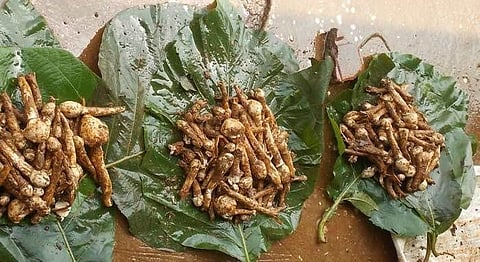
- HOMEGROWN WORLD
- #HGCREATORS
- #HGEXPLORE
- #HGVOICES
- #HGSHOP
- CAREERS
- ABOUT US
- CONTACT US

Wrapped around in newspaper and going anywhere from INR 500 - 2000 for a healthy handful, the transactions surrounding Goa’s most coveted mushroom highly resemble a narcotic exchange. And even though the experience of eating these local mushrooms is considered other-worldly by some, this phenomena is strictly restricted to dining tables with a steaming pot of Goan Alami Tonak upon them. This innocuous, albeit elusive, ‘shroom’ pops up around Goa’s many forests from July to August, although a better yield occurs towards the end of monsoon. This is the brief window period for snagging Goa’s prized ‘Alami’ mushroom – a fond figure of Goan home cooking.
The reason the price tag for these flavourful fungi is so high not only has to do with the seasonality of the mushrooms, but where they grow. Alami mushrooms grow naturally in Goa’s dense forests atop anthills or termite mounds – not the easiest environment to replicate. Although, there are apparently commercial versions of the Alami, no food lover with half a brain would swap the real deal for the replicated version that lacks the distinctive taste, quality and tradition that make up this local mushroom.
Goa is home to over a 100 species of local mushrooms, however, the well-defined nutty and earthy taste profile of the Alami crown it the regional king of fungi.
We know the long white stalks and small button heads of the Alami are perhaps not the most visually appealing mushrooms; yet, serve them up in a Alami Tonak or a Mushroom Xacuti and you’ll understand why the arrival of these indigenous veggies is rejoiced in kitchens along the coast. Either one of those dishes with a hot poi (pao/pav) is Goan home-cooking heaven. Also, if you fancy yourself nifty in the kitchen, the Alami mushroom is a great ingredient to experiment with.
And the mushroom’s fame doesn’t stop in the kitchen. The collecting of the Alami mushroom is considered a rite of passage for young men in remote parts of Goa according to Business Standard. Moreover, the taste of these fantastic forest finds is surrounded by a legend. Supposedly the guardian snake of the ant hill has to be swayed into content by the offering of a wild herb by the name of Akshar.
If all it truly takes is a wild herb and a pleased snake for these mushrooms to pop up, we sign off hoping this monsoon the forests of Goa are full of both.
